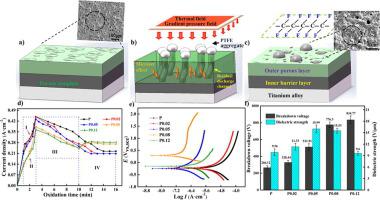Chemical Engineering Journal ( IF 13.3 ) Pub Date : 2020-07-02 , DOI: 10.1016/j.cej.2020.126116 Shuqi Wang , Yaming Wang , Yongchun Zou , Yunfeng Wu , Guoliang Chen , Jiahu Ouyang , Dechang Jia , Yu Zhou

|
The self-adjusting polytetrafluoroethylene (PTFE)/TiO2 organic-inorganic double-layer coatings are designed on titanium alloy using thermal field and gradient pressure field enhanced plasma electrolytic oxidation (TGEPEO), which leads to the in-situ incorporation of PTFE nano-particles into the bottom TiO2 ceramic coating. The PTFE top layer with adjustable thickness is strongly bonded on a TiO2 bottom porous layer by subsequent deposition, chemical bonding and crosslinking curing of PTFE nanoparticles during TGEPEO process. Simultaneously, the double-layer coating possesses promising self-cleaning function due to a special hydrophobic surface with a water contact angle of ≈138.0 ± 4.4° caused by self-adjusted surface micro-nano structure. Moreover, the PTFE/TiO2 double-layer coating exhibits excellent corrosion resistance and high electrical insulation. More importantly, the microstructure of the double-layer coating underwent self-adjustment in long-term immersion, caused by the accumulation-redeposition of corrosive ions and the closure of the reticular microchannels at the damaged regions, thus enhancing long-term chemical stability.
中文翻译:

自调节PTFE / TiO 2疏水性双层涂料,具有耐腐蚀性和电绝缘性
自调节聚四氟乙烯(PTFE)/ TiO 2有机-无机双层涂层是利用热场和梯度压力场增强等离子体电解氧化(TGEPEO)在钛合金上设计的,从而可原位掺入PTFE纳米级。颗粒进入底部TiO 2陶瓷涂层。厚度可调的PTFE顶层牢固地粘合在TiO 2上通过在TGEPEO过程中对PTFE纳米颗粒进行随后的沉积,化学键合和交联固化,形成底部多孔层。同时,由于自调节的表面微纳结构引起的特殊疏水表面的水接触角约为138.0±4.4°,因此该双层涂层具有令人满意的自清洁功能。而且,PTFE / TiO 2双层涂层显示出优异的耐腐蚀性和高电绝缘性。更重要的是,双层涂层的微观结构在长期浸没时会进行自我调节,这是由于腐蚀离子的积累-再沉积和受损区域的网状微通道的封闭所致,从而提高了长期化学稳定性。











































 京公网安备 11010802027423号
京公网安备 11010802027423号